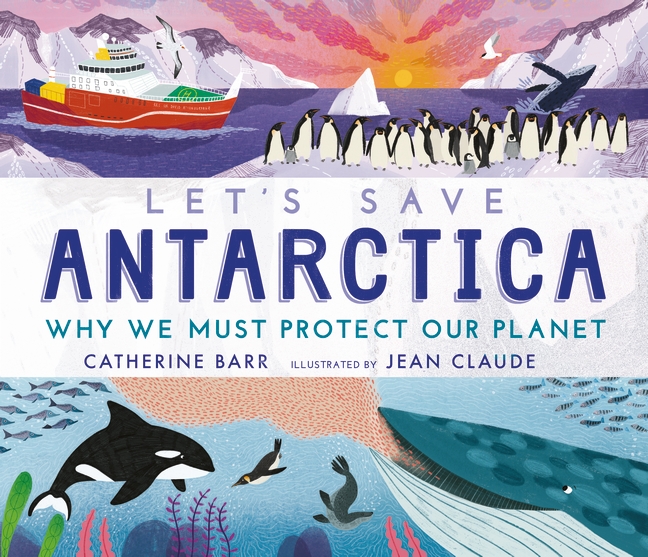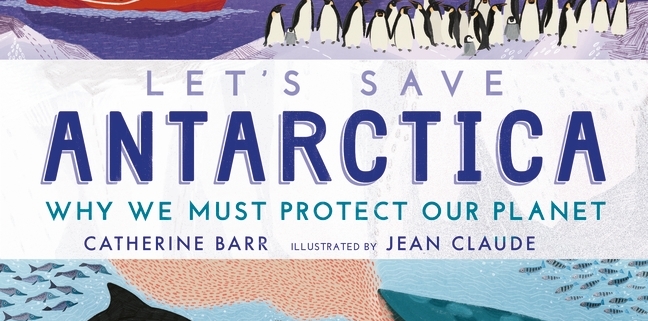@FCBGAsks…Catherine Barr
Welcome to a brand new blog feature for the Federation of Children’s Book Groups. We love interacting with authors, illustrators and publishers in new ways, and so this new format was created to get to know the creatives in children’s publishing a bit better.
This first @FCBGAsks features Catherine Barr, author of Let’s Save Antarctica. Published by Walker Books earlier this month, it is a well-researched book about Antarctica and ways we can help to save it. Read on for our @FCBGAsks feature…

You have so much experience and success in writing non-fiction books. How much research do you like to do before you write? Does it vary depending on topic?
Lots and yes! I explore so many different kinds of sources – from documentaries and TED talks to books, endless online research, drawing on my own experiences, renewing contacts from places and organizations I have worked with and, most interestingly, seeking a variety of experts in the field I am investigating. I enjoy this part of the process so much – learning from scientists working in the field. I had recently visited British Antarctic Survey as part of research for another book and so was in touch with scientists there. I am always so grateful for people’s time, wherever they are … and send lots of bars of chocolate around the world as a result! Whatever the topic, I learn and gather as much as I can to get a really clear overview and context for more detailed investigation. The more I learn, the easier it is to write a single sentence of narrative – with so few words in a picture book, the copy really needs to capture the essence of what I want to get across. I love that process of endless editing.
Was it challenging to find research and information on the Antarctic that would help you draft this book?
It was interesting and takes time to explore different sources and look at issues from different angles: deciding what to include and what to leave out; to be interesting in detail but convey the big picture to engage young readers.
Do you have plans to create more in this series? If so, where will you transport readers to next?
Yes. Let’s Save the Amazon will be published in November this year. The illustrations for Let’s Save the Great Barrier Reef are being finalized now for publication in the spring, and I’m writing final drafts for Let’s Save the Okavango Delta – the role of wetlands in the global climate change story is so important but less well known. All have been so interesting to write and I have learnt so much. I am fortunate enough to have visited (with Greenpeace) the Amazon and have also spent time in the Okavango Delta in Botswana, so both have been such a joy to revisit and research. I have been working with amazing climate and coral scientists on the copy of the Barrier Reef book and can’t wait to share – and visit one day myself, I hope.
On a typical day, how much of your time is spent writing?
Oddly, not much. Actually writing a book tends to come in short intensive bursts – most of my time is spent researching, editing, looking at layouts with my copy alongside new illustrations (which is a really exciting part of the process) and, also, working up and pitching new ideas (generally to be published two years ahead). I work on lots of different projects at the same time – which I really enjoy, but is also necessary as a full-time picture-book author.
Have you ever written or considered writing fiction for children?
My second book, Elliot’s Arctic Surprise, was a fiction story – but written with the aim of raising awareness of the threat of drilling for oil in the Arctic. And one of my most recent books, Fourteen Wolves (about the re-wilding of wolves in Yellowstone Park), is probably my most narrative non-fiction – but all based on a true story. I am interested in writing non-fiction narrative as a way to engage children in nature and science – true stories they can read themselves or read together with an adult. The reason I wrote my first book, The Story of Life: A First Book about Evolution, was that I couldn’t find this fantastic real-life “story” anywhere (at the time) – only text books. It feels unlikely for me to write fiction: I love working with illustrators and cannot imagine writing a chapter book – I’m not sure I could!
What tips would you offer children who wish to make changes in their lives to save the planet?
For me the main purpose of my writing is to encourage and inspire children’s curiosity and care for the natural world. I hope my books inspire questions and conversations – and for children (and of course adults) I think that is such an important place to start on the path to becoming an eco-warrior, however quiet or loud.
In each of the books in the Let’s Save series we have highlighted practical changes that children can make. But to me, the most important thing they can do is to take an interest, want to learn more and enthusiastically share what they know with others – to start conversations, whether at school, with friends, or over the kitchen table at home.





Leave a Reply
Want to join the discussion?Feel free to contribute!